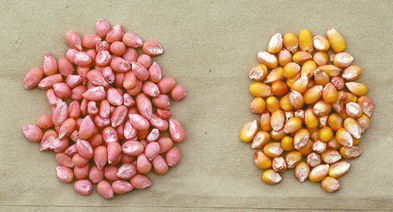|
written by: Demian Nunez and Madeline Potter Neonicotinoids are most commonly known to the public as a class of chemicals responsible for widespread pollinator decline. To growers they are a cheap means of dealing with historically difficult soil pests and are heavily used throughout the United States as a preventative measure. Given their prevalence, are the benefits enough to justify their use? Recent University of Maryland (UMD) entomology graduate Dr. Aditi Dubey, Hamby Lab, addressed this question and more in her exit seminar, summarizing five and a half years of research.  Figure 1. NST treated corn seed (left) and untreated corn seed (right) (Leonard and Willrich). Figure 1. NST treated corn seed (left) and untreated corn seed (right) (Leonard and Willrich). Neonicotinoids are the most widely used class of insecticides in the United States. Neonicotinoids are typically applied as seed treatments called NSTs, by seed producers, before sale to farmers (Figure 1). In 2011, over 30% of soybean and over 79% of corn in the United States were neonicotinoid-treated seed. There are several reasons neonicotinoids are so widespread. They possess a low mammalian toxicity and are effective for controlling challenging insect soil pests. NSTs are also usually applied with other seed treatments like fungicides at no extra cost to the farmer. Since neonicotinoids are so cheap, many farmers see it as a way to tackle multiple anticipated problems at once, making finding seed without neonicotinoid treatment difficult these days. Dr. Dubey focused her PhD research on neonicotinoid seed treatments in Maryland field crops and their effect on crop yield, arthropod communities, and the soil environment. She also examined the impacts of seed-applied fungicides since previous studies had not teased apart the impacts of fungicides and neonicotinoids, despite them often being applied together. Dr. Dubey conducted a three-year field study from 2015 to 2017 on a rotation of full-season soybean, winter wheat, double-cropped soybean, and corn at two UMD research farms in Beltsville and Queenstown, Maryland. Her treatments included fungicide-treated seeds, seeds treated with fungicide and Thiamethoxam-Cruiser 5FS (a neonicotinoid), and seeds treated with fungicide and Imidacloprid-Gaucho 600F (another neonicotinoid), as well as a control group of untreated seeds. Dr. Dubey’s first objective investigated the impact neonicotinoids have on soil health by measuring neonicotinoid persistence in the environment, impact on soil microbial activity, prokaryotic diversity, and soil quality parameters (such as soil pH and available nitrogen). While she found evidence of neonicotinoid accumulation in the soil across her study period, she found no statistical differences in soil quality between plots, and no treatment impacts. She also did not see a statistical difference in soil respiration, prokaryotic diversity, or microbial community composition between plots. Dr. Dubey suggested that the lack of discernable effect on soil quality could be attributed to rapid break down of neonicotinoids in the soil, or perhaps more concerning, rapid neonicotinoid leaching into the water table where neonicotinoids could pose unknown risks to aquatic animals and the health of the Chesapeake Bay. She also proposed two decades of neonicotinoid usage may have already caused changes in the soil, thus preventing a clear baseline of what “pristine” soil would look like. Second, Dr. Dubey sought to determine what target (intended) and non-target impacts neonicotinoids had on arthropod communities in her research plots as well as whether neonicotinoids perform their advertised function: protecting crops from pests and improving yield. The pests that neonicotinoids usually target are not an economic threat in Maryland today, and many of the same pests can be controlled through cultural practices local growers already observe. Dr. Dubey determined that some pest groups were somewhat suppressed, but pest pressure was low throughout the study anyway. There was not much impact on soil arthropods, but there was greater overall community and taxa level negative impacts on leaf arthropods. In wheat, non-target impacts were observed up to 32 weeks after planting. While investigating the fungicides’ effects, she did see some community and taxa level impacts as well. Despite some pest suppression, neonicotinoids did not produce any positive impacts on crop yield (Figure 2). ![Figure 3. Arthropod sampling methods, clockwise: foliar counts, sticky cards, litter extractions, pitfall traps (Dubey, [Slide 50]).](/uploads/4/4/1/3/44130801/published/dubey-blog-collage-image3.png?1608585517) Figure 3. Arthropod sampling methods, clockwise: foliar counts, sticky cards, litter extractions, pitfall traps (Dubey, [Slide 50]). Figure 3. Arthropod sampling methods, clockwise: foliar counts, sticky cards, litter extractions, pitfall traps (Dubey, [Slide 50]). Near-universal application of neonicotinoids may be overkill for a pest problem that is not severe or not present in Maryland. Dr. Dubey suggested that educating farmers on the risks and benefits of neonicotinoids, as well as some government oversight to promote non-NST treated seed production, could go a long way in reducing neonicotinoids in our agricultural systems. Reducing neonicotinoids would aid in conserving Maryland’s biodiversity and ecosystems. References: Dubey, Aditi. "Evaluating the potential benefits and long-term sustainability of neonicotinoid seed treatments in mid-Atlantic grain crop production." Powerpoint file, 4 Dec. 2020. Dubey, Aditi, et al. "Ecological impacts of pesticide seed treatments on arthropod communities in a grain crop rotation." Journal of Applied Ecology, vol. 57, 21 Feb. 2020, pp. 936-51, besjournals.onlinelibrary.wiley.com/doi/abs/10.1111/1365-2664.13595. "ESA Science Policy Fellows Class of 2019." Entomological Society of America, www.entsoc.org/sci-pol/SPF/2019. Leonard, Billy, and Melissa Willrich. "Seed Treatments: An Alternative Pesticide Delivery System." LSU AgCenter, Louisiana State University, 19 Oct. 2004, www.lsuagcenter.com/articles/connected/seed-treatments-an-alternative-pesticide-delivery-system. Written by: Madeline Potter is a Masters student in the Shrewsbury Lab researching the biology and ecology of Anastatus reduvii, a native parasitoid to control Halyomorpha halys. Demian Nunez is a Masters student in the Hooks Lab researching clover and bunch grass living mulches as a potential IPM tool for suppressing pests and promoting beneficial diversity in cantaloupe cropping systems. Comments are closed.
|
Categories
All
Archives
June 2024
|
Department of Entomology
University of Maryland
4112 Plant Sciences Building
College Park, MD 20742-4454
USA
Telephone: 301.405.3911
Fax: 301.314.9290
University of Maryland
4112 Plant Sciences Building
College Park, MD 20742-4454
USA
Telephone: 301.405.3911
Fax: 301.314.9290



 RSS Feed
RSS Feed




